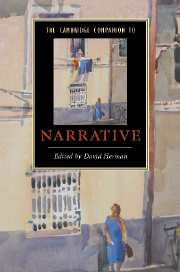Book contents
- Frontmatter
- Part I Preliminaries
- Part II Studying narrative fiction: a starter-kit
- Part III Other narrative media (a selection)
- Part IV Further contexts for narrative study
- 13 Gender
- 14 Rhetoric/ethics
- 15 Ideology
- 16 Language
- 17 Cognition, emotion, and consciousness
- 18 Identity/alterity
- Glossary
- Further reading
- Index
16 - Language
from Part IV - Further contexts for narrative study
Published online by Cambridge University Press: 28 September 2007
- Frontmatter
- Part I Preliminaries
- Part II Studying narrative fiction: a starter-kit
- Part III Other narrative media (a selection)
- Part IV Further contexts for narrative study
- 13 Gender
- 14 Rhetoric/ethics
- 15 Ideology
- 16 Language
- 17 Cognition, emotion, and consciousness
- 18 Identity/alterity
- Glossary
- Further reading
- Index
Summary
The language of a narrative: different wordings, different stories
The focus in this chapter is on the verbal detail that linguistic categories and distinctions can help us to pinpoint in the composition of literary narratives. My example text is Joyce's “Two Gallants.” Linguistic descriptions may not always be able to explain what it is in a passage of literary narrative that makes it particularly effective or striking or moving, but such descriptions can help to make us more aware of the kinds of distinct, even unique, verbal texture a text may have, and more aware of how if a story was narrated - worded - otherwise, it would have created a very different effect. It would, in fact, be a different story.
What happens in “Two Gallants”?
The following is a synopsis of James Joyce’s short story “Two Gallants,” which was published in 1914 as part of Dubliners:
Two young men, Corley and Lenehan, stroll around the twilight streets talking about women, Corley agreeing to extract money from his woman-friend at the end of his evening with her, this money to be loaned to the impecunious Lenehan. Thereafter we follow the latter as he walks the streets, reflecting on his own miserable condition, until the couple return and Corley is given a sovereign by the woman who departs and, after a brief delay, Corley displays this “tribute” to the anxiously waiting Lenehan.
- Type
- Chapter
- Information
- The Cambridge Companion to Narrative , pp. 231 - 244Publisher: Cambridge University PressPrint publication year: 2007
- 4
- Cited by

